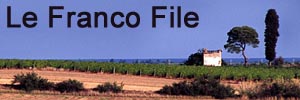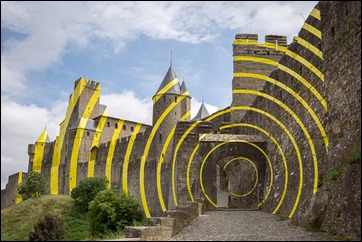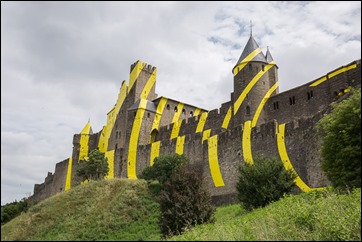France has not enjoyed a particularly settled May. The disturbed weather pattern had continued for our journey thus far. Having invested in an Aujour d’hui newspaper for the weather forecasts, we had been pleased to see that today held the promise of something brighter.
 Fellow campers, a Dutch couple, had told us of a field that was supposedly good for orchids. It was “only 3kms away” on the south side of Rosnay so we took to our bicycles for the first time in an embarrassingly long period. We cycled down through Rosnay in search of the field. We failed to find anything resembling it but we did find the hedgerows infested by large, white butterflies that didn’t look quite right for Large White butterflies, if you get my drift. Eventually one settled and I realised they were the delicately marked Black-veined White (Aporia crataegi). I’ve seen them before [they do not occur in the UK] but never in such numbers.
Fellow campers, a Dutch couple, had told us of a field that was supposedly good for orchids. It was “only 3kms away” on the south side of Rosnay so we took to our bicycles for the first time in an embarrassingly long period. We cycled down through Rosnay in search of the field. We failed to find anything resembling it but we did find the hedgerows infested by large, white butterflies that didn’t look quite right for Large White butterflies, if you get my drift. Eventually one settled and I realised they were the delicately marked Black-veined White (Aporia crataegi). I’ve seen them before [they do not occur in the UK] but never in such numbers.
We returned to Rosnay to visit the boulanger for a consolation late breakfast of almond tarts, which we washed down with coffee.
Back at Guillaume, Francine checked a different publication and discovered that the orchid field was not actually beside the road but was about 100m off it. Rats! We took to the car and returned to try again. This time we found a couple of other cars that were clearly visiting the same place. We parked and joined in.

 There were, indeed, masses of Tongue Orchids (Serapias lingua), the same species as those on our Rosnay campsite, though these were not especially photogenically arranged – no clear backgrounds. Looking further along the visitor path, we also found a lot of Lesser Butterfly Orchids (Platanthera bifolia). Francine was enchanted by the swathes of assorted wild flowers which accompanied the orchids.
There were, indeed, masses of Tongue Orchids (Serapias lingua), the same species as those on our Rosnay campsite, though these were not especially photogenically arranged – no clear backgrounds. Looking further along the visitor path, we also found a lot of Lesser Butterfly Orchids (Platanthera bifolia). Francine was enchanted by the swathes of assorted wild flowers which accompanied the orchids.
There’s usually one thing, with varying degrees of seriousness, that I forget to pack. This time, I have brought along our cheapo gas BBQ, charcoal being prohibited in much of southern France, but not the lava rocks that go inside said cheapo gas BBQ. “Bother”, said Pooh, crossly, again. We needed supplies and fuel so zoomed off to the nearby town of Le Blanc where we found both at a Leclerc supermarket. Unfortunately we failed to find any replacement lava rocks so we’re still carrying around a useless gas BBQ. Duh!
After a lunch of smoked poitrine, which I had assumed was cooked but which turned out to be raw – this is essentially French bacon – I was keen to repeat an earlier visit to an odonata hotspot called les Terres de Picadon. We’d been introduced to it some years ago by fellow odo-nutter who lives relatively locally. It’s all very well keeping ones notes/information on the Internet but you need a connection to access it. Fortunately the phones were working on xG. A swift memory jog from Google Maps got us straight to the right location. The small parking area was nearly full but we got the last spot.
I was mainly interested in the Terres de Picadon because it is reputedly home to a rare colony of dragonfly, the Lilypad Whiteface (Leucorrhinia caudalis) which we had missed on our introductory visit. We were just beyond the start of its flight season so could strike lucky. Fingers crossed, we set off along the track. Clearly I should be keeping an eye on any passing lily pads; they are not called Lilypad Whitefaces for no reason.
After a short distance, having been bitten [quelle surprise] Francine returned to the car for a dose of anti-mosi potion. We began our walk again.
We were entertained by a few dragonflies and damselflies as we wandered then, on the approach to a corner I spied a pond with lily pads on our right. Scanning through the telephoto lens revealed nothing so I continued. Around the corner was a rickety, shady bridge where we watched a couple of Downy Emeralds (Cordulia aenea) engaged in the occasional territorial spat. The pond crossed by this bridge was much larger with a lot more lily pads in its centre. I thought I saw something land on one of the farther pads. At this distance, surely it was a dragonfly rather than a damselfly. It is not unusual for damselflies to alight on lily pads but it IS unusual for a dragonfly. I snapped a picture through the 400mm lens. It was certainly a dragonfly but the range obscured much in the way of detail.
Francine had advanced round the next bend and called. She’d found one suspect on a lily pad considerably closer to the edge. Actually, it wasn’t a lily pad but the leaf of a species of pond weed. Still, let’s not be picky when a new dragonfly is possible. My image was still not huge but this was clearly my hoped for quarry, my first Lilypad Whiteface, or Pondweed Whiteface, maybe. I clicked away in excitement but really needed my 1.4X extender which was back in the car. Francine gamely volunteered to retrieve it while I kept watch, so returned to the car for a second time.
Armed with more magnification I began getting images of a decent size. The critter originally kept facing away from us but, being a new species for me and a rare one to boot, I was pretty happy with anything recognisable. This angle showed its delightful white pterostigmas and white appendages to good effect. It was keeping its compound eyes open for prey items and zooming off when it spotted something, always returning to the same perch. At last it hopped around (if a dragonfly can hop?) on the leaf, doing a few pirouettes as it eyed other prey and I managed to get both a profile and a front view, showing the eponymous white face. Ecstasy! I was a very happy camper indeed.



This was something it’s worth towing a caravan 400 miles for. Naturally, nothing was going to top the new addition to my catalogue but we continued around the reserve and notched up 12 species in all:
- Common Emerald Damselfly (Lestes sponsa)
- Azure Damselfly (Coenagrion puella)
- Small Red Damselfly (Ceriagrion tenellum)
- Large Redeye (Erythromma najas)
- White-legged Damselfly (Platycnemis pennipes)
- Blue Emperor (Anax imperator)
- Broad-bodied Chaser (Libellula depressa)
- Four-spotted Chaser (Libellula quadrimaculata)
- Broad Scarlet (Crocothemis erythraea)
- Downy Emerald (Cordulia aenea)
- Lilypad Whiteface (Leucorrhinia caudalis)
- Ruddy Darter (Sympetrum sanguineum)
On the track to the morning’s orchid field, we’d actually found what made 13 for the day:
- Southern Emerald (Lestes barbarus)
Technorati Tags:
travel,
France,
wildlife,
nature,
odonata,
butterflies,
dragonflies,
damselflies,
Terres de Picadon,
orchids,
flowers,
Rosnay
 After a brief aperitif wander around the town looking at the market which was now in shutdown mode, we repaired to the restaurant and found that it, at least, provided some shelter from the continuing strong wind. The restaurant faces a salt pan with astoundingly pink water. One day we really must get here at the right time, i.e. in the morning when the angle of the light is best for the colour and with less wind disturbing the surface, to do it justice. This will give you the idea of the effect, though. Naturally, the phrase that springs to mind is “sky blue pink”. See, that mythical colour does exist.
After a brief aperitif wander around the town looking at the market which was now in shutdown mode, we repaired to the restaurant and found that it, at least, provided some shelter from the continuing strong wind. The restaurant faces a salt pan with astoundingly pink water. One day we really must get here at the right time, i.e. in the morning when the angle of the light is best for the colour and with less wind disturbing the surface, to do it justice. This will give you the idea of the effect, though. Naturally, the phrase that springs to mind is “sky blue pink”. See, that mythical colour does exist. Studying the menu, our friends Hans and Marga fancied a seafood platter, too, so what turned up was a humongous dish laden with seafood for four. A platter order is for a minimum of two and contains a crab, oysters, raw mussels, prawns and whelks, together with the necessary hardware, bread and mayonnaise. We added a bottle of white wine, of course. Maternal remonstrations not to play with ones food are useless faced with a such a feast. We all set about manually attempting to destroy it and very nearly succeeded – very nearly but not quite; a few bulots [whelks] went back with a moule [mussel] or two.
Studying the menu, our friends Hans and Marga fancied a seafood platter, too, so what turned up was a humongous dish laden with seafood for four. A platter order is for a minimum of two and contains a crab, oysters, raw mussels, prawns and whelks, together with the necessary hardware, bread and mayonnaise. We added a bottle of white wine, of course. Maternal remonstrations not to play with ones food are useless faced with a such a feast. We all set about manually attempting to destroy it and very nearly succeeded – very nearly but not quite; a few bulots [whelks] went back with a moule [mussel] or two.





























Recent Comments